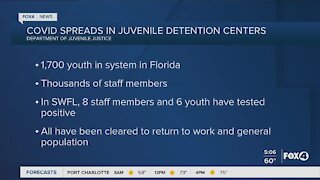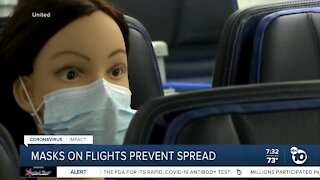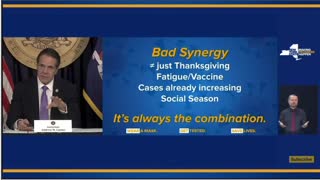Premium Only Content

New Chinese Study - No COVID Spread Between Asymptomatics, 3427
I’m Still reporting on the coup.
The cornerstone justification for the mandatory mask wearing, social distancing, and economic lockdowns may have just taken a severe blow – from the Chinese, no less!
The groundbreaking study was published on Nov. 20 in the respected British journal, “Nature Communications” and may indicate that the Chinese government is attempting to get on the right side of history of the COVID-19 debacle.
Due to the rapidly-spreading virus on January 23, 2020, the city of Wuhan, China imposed what the study calls “stringent COVID-19 control measures.” The word “stringent” may be a bit too mild, but that’s another topic. Wuhan residents endured these control measures for 2-1/2 months, until the government lifted the lockdown on April 8, 2020.
On April 8th, the city began to return to normal life, both in employment and social life.
Surprisingly, in the U.S. the number of Americans who tested positive continued to climb for the rest of 2020, but in Wuhan, in the one-month period after the lockdown, only 6 new cases were confirmed in a city of ten million people.
Researchers wanted to study this, so the city decided to offer a COVID test to every city resident 6 years and older and from May 14th to June 1, 9,899,828 participated. That’s a lot of data! Incredibly, over the test period, no new symptomatic cases were identified. In other words, new outbreaks of serious disease were over. Herd immunity had apparently been reached.
However, 300 people did test positive for COVID, but had no symptoms – called asymptomatic cases.
The researchers zeroed in on this group of 300 and then examined the tests of 1,174 people who were their close contacts. So, each asymptomatic COVID case had, on average, 4 people with whom they had close contact.
But surprisingly, there were no positive tests amongst the 1,174 close contacts – zero!
Then the researchers looked at 34,424 people who had previously recovered from COVID-19. Only 107 of them tested positive again – a “re-positive” rate of only 0.31%.
So, in other words, only one-third of 1% of Chinese nationals either caught COVID again, or never really killed off all of the virus – a remarkably small number!
The researchers conclusion:
“The detection rate of asymptomatic positive cases was very low, and there was no evidence of transmission from asymptomatic positive persons to traced close contacts.”
“Compared with symptomatic patients, asymptomatic infected persons generally have low quantity of viral loads and a short duration of viral shedding, which decrease the transmission risk of SARS-CoV-2.”
“All close contacts of the asymptomatic positive cases tested negative, indicating that the asymptomatic positive cases detected in this study were unlikely to be infectious.”
If that’s not enough, the researchers found the same thing in those who were found to be infected a second time.
“Results of virus culturing and contact tracing found no evidence that re-positive cases in recovered COVID-19 patients were infectious, which is consistent with evidence from other sources.”
“A study in Korea found no confirmed COVID-19 cases by monitoring 790 contacts of 285 repositive cases.”
“The official surveillance of recovered COVID-19 patients in China also revealed no evidence on the infectiousness of repositive cases.”
In addition, the researchers found a correlation between the re-positive people and how much disease was present in their communities at the peak of the infection.
“We found that asymptomatic positive rates in different districts of Wuhan were correlated with the prevalence of previously confirmed cases.”
They also found evidence that the virus tends to weaken over time.
“…newly infected persons were more likely to be asymptomatic and with a lower viral load than earlier infected cases.”
“When susceptible residents are exposed to a low dose of virus, they may tend to be asymptomatic as a result of their own immunity.”
So, apparently, herd immunity is more a matter of degree – an initial low-viral load dose yields a patient who tends to be more asymptomatic.
However, erring on the side of caution – not to mention the attendant medical liability – the study concluded that the wearing of masks and safe social distancing in Wuhan should be maintained, especially in vulnerable populations with weak immune systems or co-morbidities.
One must wonder, however, if a population of those who refused to wear masks could be tested, would the results be any different? The huge numbers involved in this study seems to indicate that lockdowns, masks, and social distancing would make no difference among people mingling normally in public settings – where severely infected patients do not go.
I’m still reporting from just outside the citadel of world freedom. Good day.
https://www.nature.com/articles/s41467-020-19802-w#Tab1
-
 5:18
5:18
The Still Report
2 days agoJoe DiGenova – Obama Does Not Have Immunity, 4777
7617 -
 1:53
1:53
KGTV
5 years agoNew study could stop spread of COVID -19
2361 -
 2:16
2:16
WXYZ
4 years agoNew restrictions to stop COVID spread
2581 -
 8:01
8:01
CaptainKirk
4 years ago $0.72 earnedExposed Covid 19 Chinese weapon
2.02K1 -
 0:25
0:25
KTNV
4 years agoRTC taking new precautions to stop COVID spread
314 -
 0:26
0:26
WFTX
4 years agoCovid spread in Juvenile Detention Centers
60 -
 5:19
5:19
stevenjsargent
4 years agoChinese doctor exposed CCP covid coverup
3.45K5 -
 2:10
2:10
KGTV
4 years agoStudy: Masks on flights prevent spread
1705 -
 2:17
2:17
BonginoReport
4 years agoGov. Cuomo Blames New Yorkers for COVID Spread
39K30 -
 2:13
2:13
KIVI
4 years agoSt. Luke's COVID Mental Health Impact Study
51